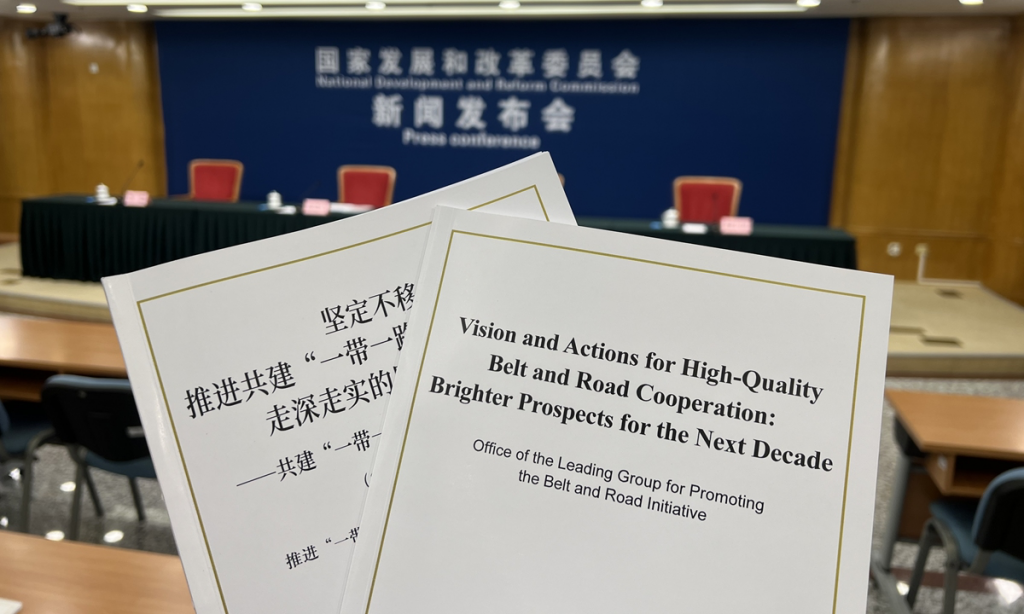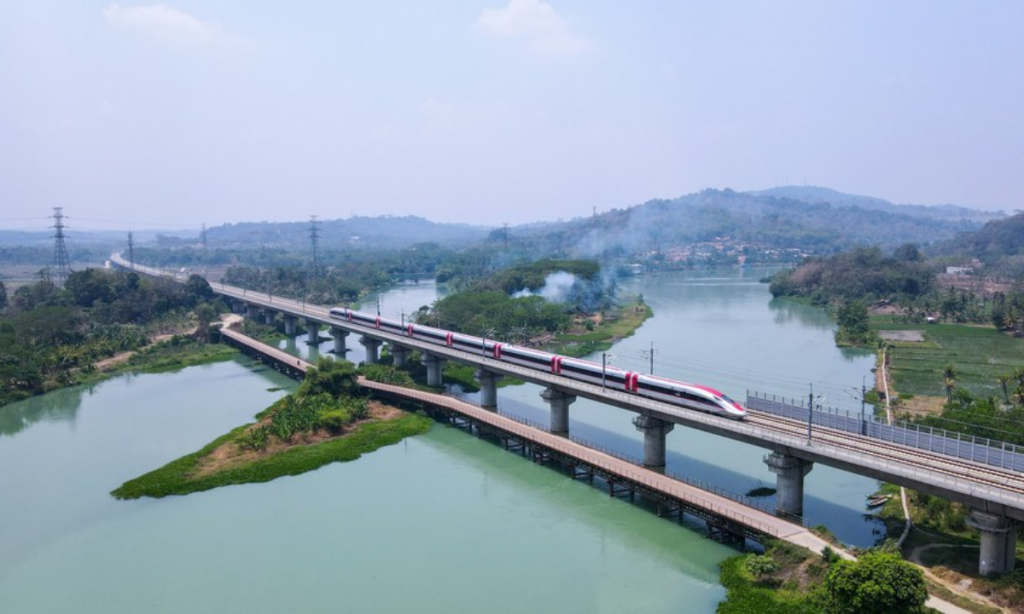Published: November 26,2023
By GT staff

Vision and Actions for High-Quality Belt and Road Cooperation: Brighter Prospects for the Next Decade Photo: Tao Mingyang/GT
China on Friday published a document entitled “Vision and Actions for High-Quality Belt and Road Cooperation: Brighter Prospects for the Next Decade,” which specified the key areas and directions for Belt and Road cooperation in the next 10 years.
The China-proposed Belt and Road Initiative (BRI) has injected new growth momentum into the world economy and created vast room for global development. The initiative is believed to bring benefits to its partner countries through the newly released vision and action plan for BRI’s development in the next decade, with some new focuses on green and digital development, as well as the stability and sustainability of supply chains.
From a China-proposed initiative to an international practice, the BRI, which celebrates its 10th anniversary in 2023, has become a well-received international public good and a platform for international cooperation.
Analysts noted that the new action plan comes in time for future development, as the next “golden decade” for BRI starts and the plan involves new industries and global concerns. New cooperation sectors such as innovation, the digital economy and green development should be explored to inject vitality and momentum into the BRI, they said.

This aerial photo taken on Sep 30, 2023 shows a high-speed electrical multiple unit (EMU) train of the Jakarta-Bandung High-Speed Railway running in Purwakarta, Indonesia. Photo:Xinhua
New focuses
In addition to what the BRI has been devoted to in the past decade – policy coordination, infrastructure connectivity, unimpeded trade, financial integration and people-to-people ties – the Friday document added cooperation in new fields: green development, new forms and models of digital cooperation, technology innovation, international cooperation in health, according to the document.
The new action plan will also focus on promoting the organic integration of trade and the latest technologies, including internet, Internet of Things, big data, artificial intelligence (AI) and blockchain.
As mentioned in the document, in the next decade, all parties will be encouraged to strive toward equal cooperation and mutual benefit, propelling BRI cooperation into a new phase characterized by high-quality development, according to the Xinhua News Agency.
There is vast opportunity for digital cooperation between China and BRI partner countries, as China has extensive experience in digital infrastructure construction and digital development. At the same time, China has a huge number of digitalized industries, Wang Peng, an associate researcher with the Beijing Academy of Social Sciences, told the Global Times on Friday.
“In terms of AI, China and BRI partners can strengthen cooperation and exchanges on AI governance and rules, and research and development of AI technology,” said Wang.
As the high-quality development of the BRI enters a new stage, partner countries hope to strengthen technological cooperation with China to help their own development of intelligent manufacturing and digital economy, said Wang.
During a Friday press conference that outlined the new BRI action plan, Chinese officials also said that making industrial and supply chains more resilient and expanding the scope of free trade agreements will be a focus of BRI cooperation in the future.
Analysts and enterprises said that deepening international cooperation under the BRI will provide important impetus to the operations of the global industrial chain and supply chain.
From the perspective of the layout of the global industrial chains and supply chains, China is one of the key nodes, Hu Qimu, deputy secretary-general of the digital-real economies integration Forum 50, told the Global Times.
“What we are advocating is mutual benefit and win-win. Therefore, China plays a very important role in the development of global trade, as well as the stability of industries and supply chains. In particular, global trade protectionism has been prevalent in recent years, but China has always been committed to opening-up,” said Hu.
In the past 10 years, the total import and export volume of China and BRI partner countries has reached $19.1 trillion, and two-way investment has exceeded $380 billion, according to statistics from the National Development and Reform Commission (NDRC), the country’s top economic planner.
A large number of BRI cooperation projects in agriculture, energy, digital economy and other fields has been carried out, strongly promoting the upgrading of industrial structure and the optimization of industrial chains in various countries, said NDRC.
For example, a total of 79,900 China-Europe Railway Express trains have reached more than 200 cities in 25 European countries, becoming a “golden channel” for stabilizing the global supply chain.

This aerial photo taken on Nov. 4, 2023 shows cargo trains waiting for departure at the Alataw Pass in northwest China’s Xinjiang Uygur Autonomous Region. Located in the Mongolian Autonomous Prefecture of Bortala in Xinjiang, the Alataw Pass borders Kazakhstan. Since 2011 when the first China-Europe freight train passed through it, the pass has handled more than 30,000 trains to Central Asia or Europe.(Photo: Xinhua)
Well prepared
The BRI has gradually progressed from an idea into actions and from vision to reality by yielding fruitful results to countries and people around the world. Now China aims to promote high-quality, sustainable and people-centered development of the BRI through joint efforts to bring brighter prospects for the next decade, Maya Majueran, director of Belt and Road Initiative Sri Lanka (BRISL), a Sri Lanka-based organization that specializes in BRI cooperation, told the Global Times on Friday.
“No doubt that BRI will bring more and more benefits to partner countries and wealth and strength to the Global South and change the geopolitical balance between East and West,” said Majueran.
China is well prepared to promote the high-quality development of BRI in the future.
The third Belt and Road Forum for International Cooperation held in October produced 458 deliverables, and Chinese financial institutions established a financing window of 780 billion ($109 billion) for BRI projects. All this will contribute to high-quality BRI cooperation, and provide strong momentum for connectivity, development and prosperity around the world, an official said on Friday at the press conference.
“It is precisely because of the financing provided by BRI that our large-scale projects can be implemented in BRI partner countries, enabling more countries to achieve energy transformations,” Zhu Daocheng, vice president of JA SOLAR, a Chinese photovoltaic power firm that has an extensive presence in BRI countries, told the Global Times.
Zhu noted that more countries are expected to benefit from BRI in green development.
Open to all
“China has always been committed to working together to resolve the global development deficit and offer inclusive development that delivers benefits to all through BRI. Through this high-quality BRI vision, China highlights its responsibility for and contributions to the world, which not only focuses on benefits for the Chinese people, but also benefits the people of the world,” said Majueran.
At present, China has signed more than 200 documents with 152 countries and 32 international organizations on cooperation under the BRI, covering 83 percent of the countries with which China has established diplomatic relations, according to official statistics.
The Gulf Cooperation Council has been one of the biggest beneficiaries of the BRI, Hazem Ben-Gacem, CEO of InvestCorp, the largest non-sovereign wealth fund private equity platform in the Middle East, told the Global Times.
“The mutually beneficial and win-win concept of the BRI is greatly appreciated and respected by investors from the Middle East,” Ben-Gacem said.
Majueran noted that the West is jealous of BRI and accused China of engaging in “debt trap” diplomacy to discredit the initiative.
“A number of latest studies including Western studies show that there is no evidence of a so-called debt trap. The West proposed multiple initiatives to counter the BRI such as Partnership for Global Infrastructure and Investment, but they were all talk with no action,” Majueran noted.
China’s move is in stark contrast to the US-led Western world’s “small yard, high fence” approach of walling itself off from global cooperation, Bao Jianyun, director of the Center for International Political Economy Studies at Renmin University of China, told the Global Times.
globaltimes.cn
 Africa -China Review Africa -China Cooperation and Transformation
Africa -China Review Africa -China Cooperation and Transformation
